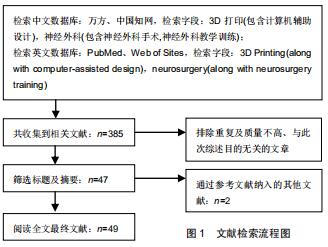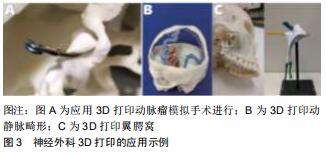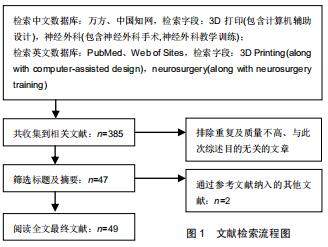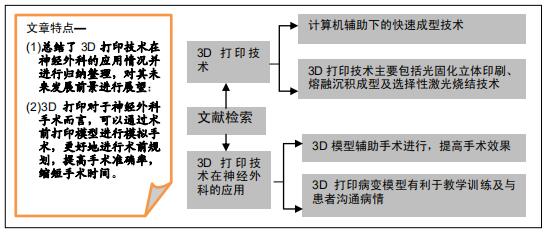|
[1] CHANDEKAR A, MISHRA DK, SHARMA S, et al. 3D Printing technology: a new milestone in the development of pharmaceuticals. Curr Pharm Des. 2019;25(9):937-945.
[2] KHAN FA, NARASIMHAN K, SWATHI CSV, et al. 3D Printing technology in customized drug delivery system: current state of the art, prospective and the challenges. Curr Pharm Des. 2018; 24(42):5049-5061.
[3] MARTÍN-NOGUEROL T, PAULANO-GODINO F, RIASCOS RF, et al. Hybrid computed tomography and magnetic resonance imaging 3D printed models for neurosurgery planning. Ann Transl Med. 2019;7(22):684.
[4] OKONOGI S, KONDO K, HARADA N, et al. Operative simulation of anterior clinoidectomy using a rapid prototyping model molded by a three-dimensional printer. Acta Neurochir (Wien). 2017; 159(9):1619-1626.
[5] LEAL AG, MORI YT, NOHAMA P, et al. Three-Dimensional hollow elastic models for intracranial aneurysm clipping election - a case study. Conf Proc IEEE Eng Med Biol Soc. 2019;2019:4137-4140.
[6] QUAN H, ZHANG T, XU H, et al. Photo-curing 3D printing technique and its challenges. Bioact Mater. 2020;5(1):110-115.
[7] MAZZANTI V, MALAGUTTI L, MOLLICA F. FDM 3D Printing of polymers containing natural fillers: a review of their mechanical properties. Polymers (Basel). 2019;11(7). pii: E1094.
[8] RAMU M, ANANTHASUBRAMANIAN M, KUMARESAN T, et al. Optimization of the configuration of porous bone scaffolds made of Polyamide/Hydroxyapatite composites using Selective Laser Sintering for tissue engineering applications. Biomed Mater Eng. 2018;29(6):739-755.
[9] PARK EK, LIM JY, YUN IS, et al. Cranioplasty enhanced by three-dimensional printing: custom-made three-dimensional- printed titanium implants for skull defects. J Craniofac Surg. 2016;27(4):943-949.
[10] HUANG MT, JUAN PK, CHEN SY, et al. The potential of the three-dimensional printed titanium mesh implant for cranioplasty surgery applications: biomechanical behaviors and surface properties. Mater Sci Eng C Mater Biol Appl. 2019;97:412-419.
[11] ESSAYED WI, UNADKAT P, HOSNY A, et al. 3D printing and intraoperative neuronavigation tailoring for skull base reconstruction after extended endoscopic endonasal surgery: proof of concept. J Neurosurg. 2018;130(1):248-255.
[12] PANESAR SS, BELO JTA, D'SOUZA RN. Feasibility of clinician-facilitated three-dimensional printing of synthetic cranioplasty flaps. World Neurosurg. 2018;113:e628-e637.
[13] TAN ET, LING JM, DINESH SK. The feasibility of producing patient-specific acrylic cranioplasty implants with a low-cost 3D printer. J J Neurosurg. 2016;124(5):1531-1537.
[14] COELHO G, CHAVES TMF, GOES AF, et al. Multimaterial 3D printing preoperative planning for frontoethmoidal meningoencephalocele surgery. Childs Nerv Syst. 2018;34(4): 749-756.
[15] PIJPKER PAJ, WAGEMAKERS M, KRAEIMA J, et al. Three-Dimensional printed polymethylmethacrylate casting molds for posterior fossa reconstruction in the surgical treatment of chiari I malformation: technical note and illustrative cases. World Neurosurg. 2019;129:148-156.
[16] YUAN T, JIA G, YANG L, et al. Occipitocervical fusion combined with 3-dimensional navigation and 3-dimensional printing technology for the treatment of atlantoaxial dislocation with basilar invagination: a case report. Medicine (Baltimore). 2020;99(5): e18983.
[17] DU YQ, QIAO GY, YIN YH, et al. Usefulness of 3D printed models in the management of complex craniovertebral junction anomalies: choice of treatment strategy, design of screw trajectory, and protection of vertebral artery. World Neurosurg. 2020;133: e722-e729.
[18] FINGERLIN TJ, RYCHEN J, ROETHLISBERGER M, et al. Long-term aneurysm recurrence and de novo aneurysm formation after surgical treatment of unruptured intracranial aneurysms: a cohort study and systematic review. Neurol Res. 2020;42(4): 338-345.
[19] SULLIVAN S, AGUILAR-SALINAS P, SANTOS R, et al. Three-dimensional printing and neuroendovascular simulation for the treatment of a pediatric intracranial aneurysm: case report. J Neurosurg Pediatr. 2018;22(6):672-677.
[20] LAN Q, ZHU Q, XU L, et al. Application of 3D-Printed craniocerebral model in simulated surgery for complex intracranial lesions. World Neurosurg. 2020;134:e761-e770.
[21] ALBA S, FEDERICA T, ALESSIO A, et al. A workflow to generate physical 3D models of cerebral aneurysms applying open source freeware for CAD modeling and 3D printing. Interdiscip Neurosurg. 2019;17:1-6.
[22] ANDERSON JR, THOMPSON WL, ALKATTAN AK, et al. Three-dimensional printing of anatomically accurate, patient specific intracranial aneurysm models. J Neurointerv Surg. 2016; 8(5):517-520.
[23] KANEKO N, MASHIKO T, NAMBA K, et al. A patient-specific intracranial aneurysm model with endothelial lining: a novel in vitro approach to bridge the gap between biology and flow dynamics. J Neurointerv Surg. 2018;10(3):306-309.
[24] UNNITHAN A. Overview of the current concepts in the management of arteriovenous malformations of the brain. Postgrad Med J. 2020;96(1134):212-220.
[25] CONTI A, PONTORIERO A, IATÌ G, et al. 3D-Printing of Arteriovenous Malformations for Radiosurgical Treatment: Pushing Anatomy Understanding to Real Boundaries. Cureus. 2016;8(4):e594.
[26] 陈光忠,李鉴轶,秦琨,等. 3D打印技术在颅内动静脉畸形血管内介入治疗中的初步应用[J].中国脑血管病杂志,2016,13(1):25-28.
[27] THAWANI JP, PISAPIA JM, SINGH N, et al. Three-dimensional printed modeling of an arteriovenous malformation including blood flow. World Neurosurg. 2016;90:675-683.
[28] DONG M, CHEN G, LI J, et al. Three-dimensional brain arteriovenous malformation models for clinical use and resident training. Medicine (Baltimore). 2018;97(3):e9516.
[29] SHAH A, JANKHARIA B, GOEL A. Three-dimensional model printing for surgery on arteriovenous malformations. Neurol India. 2017;65(6):1350-1354.
[30] GOVSA F, KARAKAS AB, OZER MA, et al. Development of life-size patient-specific 3D-printed dural venous models for preoperative planning. World Neurosurg. 2018;110:e141-e149.
[31] ROMERO-GARCIA R, EREZ Y, OLIVER G, et al. Practical application of networks in neurosurgery: combined 3D printing, neuronavigation, and preoperative surgical planning. World Neurosurg. 2020. pii: S1878-8750(20)30103-0.
[32] KOSTERHON M, NEUFURTH M, NEULEN A, et al. Multicolor 3D printing of complex intracranial tumors in neurosurgery. J Vis Exp. 2020;155: e60471.
[33] ZHANG H, LIU G, TONG XG, et al. Application of three-dimensional printing technology in the surgical treatment of nasal skull base tumor. Zhonghua Er Bi Yan Hou Tou Jing Wai Ke Za Zhi. 2018;53(10):780-784.
[34] ZHAO S, DENG M, CAI H, et al. Clinical efficacy evaluation for treating trigeminal neuralgia using a personalized digital guide plate-assisted temperature-controlled radiofrequency. J Craniofac Surg. 2018;29(5):1322-1326.
[35] MOBBS RJ, COUGHLAN M, THOMPSON R, et al. The utility of 3D printing for surgical planning and patient-specific implant design for complex spinal pathologies: case report. J Neurosurg Spine. 2017;26(4):513-518.
[36] ZHANG YW, DENG L, ZHANG XX, et al. Three-Dimensional printing-assisted cervical anterior bilateral pedicle screw fixation of artificial vertebral body for cervical tuberculosis. World Neurosurg. 2019;127:25-30.
[37] SUGAWARA T, HIGASHIYAMA N, KANEYAMA S, et al. Accurate and simple screw insertion procedure with patient-specific screw guide templates for posterior C1- C2 fixation. Spine (Phila Pa 1976). 2017;42(6):E340-E346.
[38] LI F, HUANG X, WANG K, et al. Preparation and assessment of an individualized navigation template for lower cervical anterior transpedicular screw insertion using a three-dimensional printing technique. Spine (Phila Pa 1976). 2018;43(6):E348-E356.
[39] BANNON R, PARIHAR S, SKARPARIS Y, et al. 3D printing the pterygopalatine fossa: a negative space model of a complex structure. Surg Radiol Anat. 2018;40(2):185-191.
[40] TAI BL, ROONEY D, STEPHENSON F, et al. Development of a 3D-printed external ventricular drain placement simulator: technical note. J Neurosurg. 2015;123(4):1070-1076.
[41] 相建,李珍珠,李泽福.3D打印引导下外伤性脑内血肿微创穿刺引流术[J].中华神经创伤外科电子杂志,2016,2(1):31-33.
[42] GHIZONI E, DE SOUZA JPSAS, RAPOSO-AMARAL CE, et al. 3D-Printed craniosynostosis model: new simulation surgical tool. World Neurosurg. 2018;109:356-361.
[43] CLIFTON W, NOTTMEIER E, EDWARDS S, et al. Development of a novel 3D printed phantom for teaching neurosurgical trainees the freehand technique of C2 laminar screw placement. World Neurosurg. 2019;129:e812-e820.
[44] NAGASSA RG, MCMENAMIN PG, ADAMS JW, et al. Advanced 3D printed model of middle cerebral artery aneurysms for neurosurgery simulation. 3D Print Med. 2019;5(1):11-16.
[45] LIN QS, LIN YX, WU XY, et al. Utility of 3-Dimensional-Printed models in enhancing the learning curve of surgery of tuberculum sellae meningioma. World Neurosurg. 2018;113:e222-e231.
[46] YI X, DING C, XU H, et al. Three-Dimensional printed models in anatomy education of the ventricular system: a randomized controlled study. World Neurosurg. 2019;125:e891-e901.
[47] CLEARY DR, SILER DA, WHITNEY N, et al. A microcontroller- based simulation of dural venous sinus injury for neurosurgical training. J Neurosurg. 2018;128(5):1553-1559.
[48] HARTLEY BR, ELOWITZ E. Barriers to the enhancement of effective communication in neurosurgery. World Neurosurg. 2020; 133:466-473.
[49] EISENMENGER LB, WIGGINS RH, FULTS DW, et al. Application of 3-Dimensional printing in a case of osteogenesis imperfecta for patient education, anatomic understanding, preoperative planning, and intraoperative evaluation. World Neurosurg. 2017;107:1049. e1-1049.e7.
|





